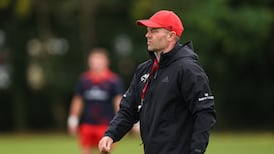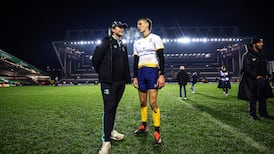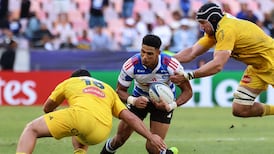Watching Leinster play without Seán O'Brien on Sunday, only confirmed again how difficult it will be for them if and when he moves to France.
It was a great win to get, especially considering how difficult most teams have found beating Castres on their own patch. But as well as the players who've been coming in in his place have played, in the longer term, there's no doubt they – and Ireland – will miss him massively if he goes.
Not everyone makes an impact on every play but that’s the key to what O’Brien does.
He has really matured as a player this season and he’s different now to the player who came on the scene.
At the beginning, he was all about big carries but his game has become more rounded. His immense power is still his greatest weapon but it’s what he has done with that weapon that has really developed as he’s got older.
Being full of energy is one thing but knowing what to do with it is what turns you into a player. To be a top-class backrow, your reading of the game has to be right on the money. The best ones are those who anticipate the next play that bit quicker than everyone else.
When O’Brien started out, he didn’t always follow the ball well enough. He wasn’t always at the right spot to cause the biggest impact – and if you don’t have that, it doesn’t matter how powerful you are.
Ball-carrying, poaching, cleaning out rucks – these are the bread and butter of a good backrow and all three depend, first and foremost, on you being in the right place at the right time.
Go back to Leinster's opening two Heineken Cup games this season, Ospreys away and Castres at home. Against Ospreys, Leinster had nine turnovers and O'Brien was responsible for three of them. Against Castres, he had four from eight. Nobody else had more than one.
Stats can sometimes lie but they often tell the truth as well and give you a decent impression of what has happened.
The way rugby has gone, with such an emphasis on defence and so many strategies for shutting teams down, the worth of somebody like O’Brien is huge.
A lot of teams use their defensive system as a weapon, allowing the opposition to have the ball and biding their time until they can isolate somebody and force a penalty.
You need someone with a lot of power and perfect timing to go into a ruck and come out with either the ball or a penalty. O’Brien always had the first bit and he has developed the second bit.
What it means is he can influence games now in more than just one. His ball-carrying will always be a big part of what he brings but he couldn't afford to be one-dimensional. By improving his reading of the game and his timing, he now changes the course of matches. He's one of those rare players who can turn the momentum of a game.
A lot like Wally
In that way, he reminds me a lot of David Wallace. Players who have that sort of natural power are such an advantage to a team. When Wally made a carry, invariably he got across the gain line. When he got into a ruck, he slowed the opposition ball down and often forced a turnover.
I played with Wally for so many years that he eventually made me look good. He carried so much that whether it was me and Denis Leamy or me and Anthony Foley playing alongside him, our lives were made easier by the fact the opposition always targeted him.
You could see it happening just by watching who they were watching. Peter Stringer could be at the base of a ruck and just as he went to pick the ball to pass it out, a couple of guys would start to jam inside ready to hop on Wally as soon as he got the ball. It often happened that Stringer would see it too and decide to skip Wally at the last second and the ball would land in my hands, leaving me or Leamy or Foley with only one tackle to break.
Afterwards, you’d be getting congratulated for a line-break but you knew it was really down to the threat posed by Wally. Because he had such a powerful leg drive, other teams knew that trying to stop him with just one tackler was pointless.
He was a threat every time he stood in the line and that automatically made whoever was standing one off him a bigger threat. It also gave the backline a bit more space if Stringer decided to go behind us and set O’Gara moving.
And sometimes we just said to hell with it and told him, ‘There you go Wally’ and gave him the ball. When you’ve got somebody that dynamic, you don’t need to complicate it.
The same goes for Seán O’Brien. Sometimes it’s just a matter of throwing him the ball and letting him do what he does.
When O’Brien carries, he nearly always makes a couple of yards, at least. That might sound like little enough but every little bit makes a difference and if nothing else it does psychological damage. Don’t underestimate how energy-sapping it is to be a defending team who is always going back on its heels.
The gain line is the key battleground in every rugby game. Break the gain line even just a little bit and every player in the opposition line has to retreat. Do it enough and they start to panic. Do it well enough and they start to lose their discipline. You can make the game very simple if you have the carriers to punch the holes like that.
Too lateral
You only have to look at Munster's first try against Gloucester last Saturday to see how it can work. Munster's big problem all season is they've been too lateral and haven't broken the gain line enough. They've tried to put width on their game but have struggled to find the space to do it successfully.
But for Keith Earls’s first try, they did the simple thing off a line-out. The put it through the hands of their main carriers and each of them pushed Gloucester back.
None of them was hugely significant and there was no big line break but they all put the opposition into retreat. BJ Botha, Paul O’Connell and Tommy O’Donnell and David Kilcoyne all got involved with dynamic carries.
Bit by bit, that wears the opposition down. Those five or six phases probably only moved the play around 15 to 20 yards. But because Gloucester were constantly having to drop back and continually having to send men in to tackle, their system started to lose its shape.
Eventually, the Gloucester fullback Martyn Thomas came up to join the defensive line to help out. Ian Keatley saw this and put the grubber in behind.
The best sign of how effective Munster’s ball-carrying had been was that when the kick bounced up, not only did Earls have a free run to the line but Peter O’Mahony was there too, with nobody to tackle either of them. It wasn’t the flashiest try in the world but it showed how simple the game can be when you have effective ball-carriers.
That’s one of the reasons why Leinster have been so dominant over the past few seasons. Their great strength has been to simplify the game while doing everything at pace and with intensity.
If you’re defending against Leinster, everything is happening at breakneck speed. You make one tackle, you get up, you get in line and you barely have yourself set before you have to make another.
The ball comes out so quickly somebody somewhere along your backline is going to make a mistake eventually. It need only be a tiny mistake – not quick enough back in the line, not spotting a bad match-up – and that’s that, Leinster are gone past you.
It sounds like a simple strategy but when it’s done accurately at pace and with intensity, it’s incredible hard to defend against.
Which is why somebody like O’Brien is so important. Ask any scrumhalf who he wants to play behind and his answer will be somebody who gets over the gain line and has the strength and technique to present him with quick, clean ball.
Every scrumhalf looks great when he can just come in and sweep the next pass away without having to dig at the bottom of a ruck.
Because O'Brien has such phenomenal leg drive, it's very rare that he is tackled high. Tacklers go low on him because they know that it's the only way to bring him down. When he gets leg-tackled, he pivots on the ground to lay the ball back and right away the scrumhalf is in to take crisp, clean ball. That's what makes him so valuable.
Miss him massively
Ireland are going to miss him massively in the Six Nations. His game-management will be missed just as much as his ball-carrying. He is like a cat waiting to pounce now at ruck time, deciding whether to go for the steal or to wait. He picks his moments and then goes in hell for leather after the ball.
And if he can’t get it, his power means that once he gets into a low body position his ability to counter-ruck just cleans out whoever’s in there wrestling with him.
Without him, Ireland will probably choose between Chris Henry and Tommy O'Donnell for the number seven shirt in the Six Nations. Jordi Murphy has stepped up for Leinster – and it's no coincidence Leinster have started playing him at seven – but it's going to be a bit early for him.
I’d imagine Henry is probably the front-runner. He’s a different kind of player to O’Brien, but then most players are. You don’t get three or four of them at the one time who bring that whole package of dynamism and game reading.
Seán O’Brien is a player who is going to be very hard to replace. Ireland are about to find that out in the Six Nations and it will be very tough on Leinster if they have to do the same.










